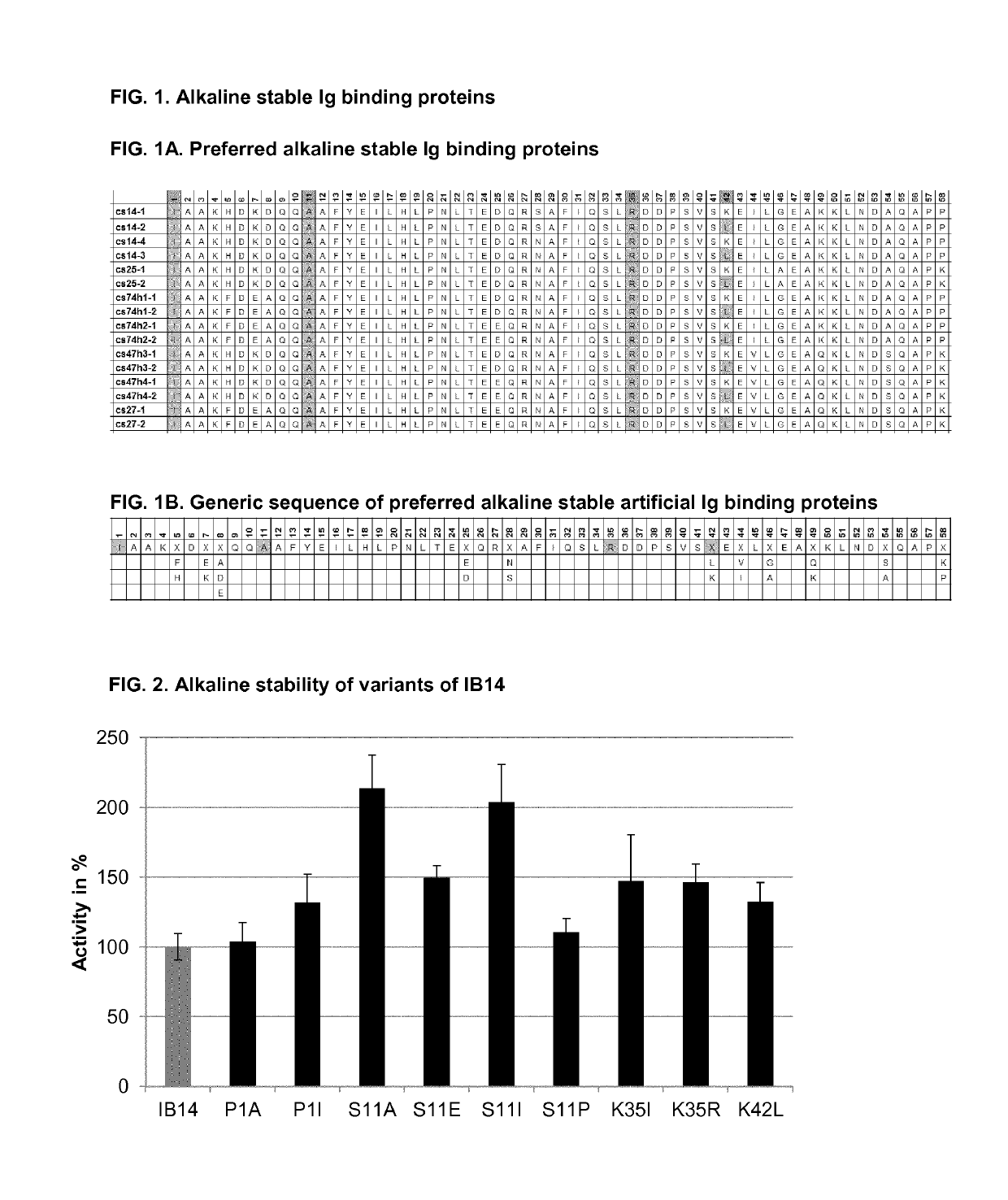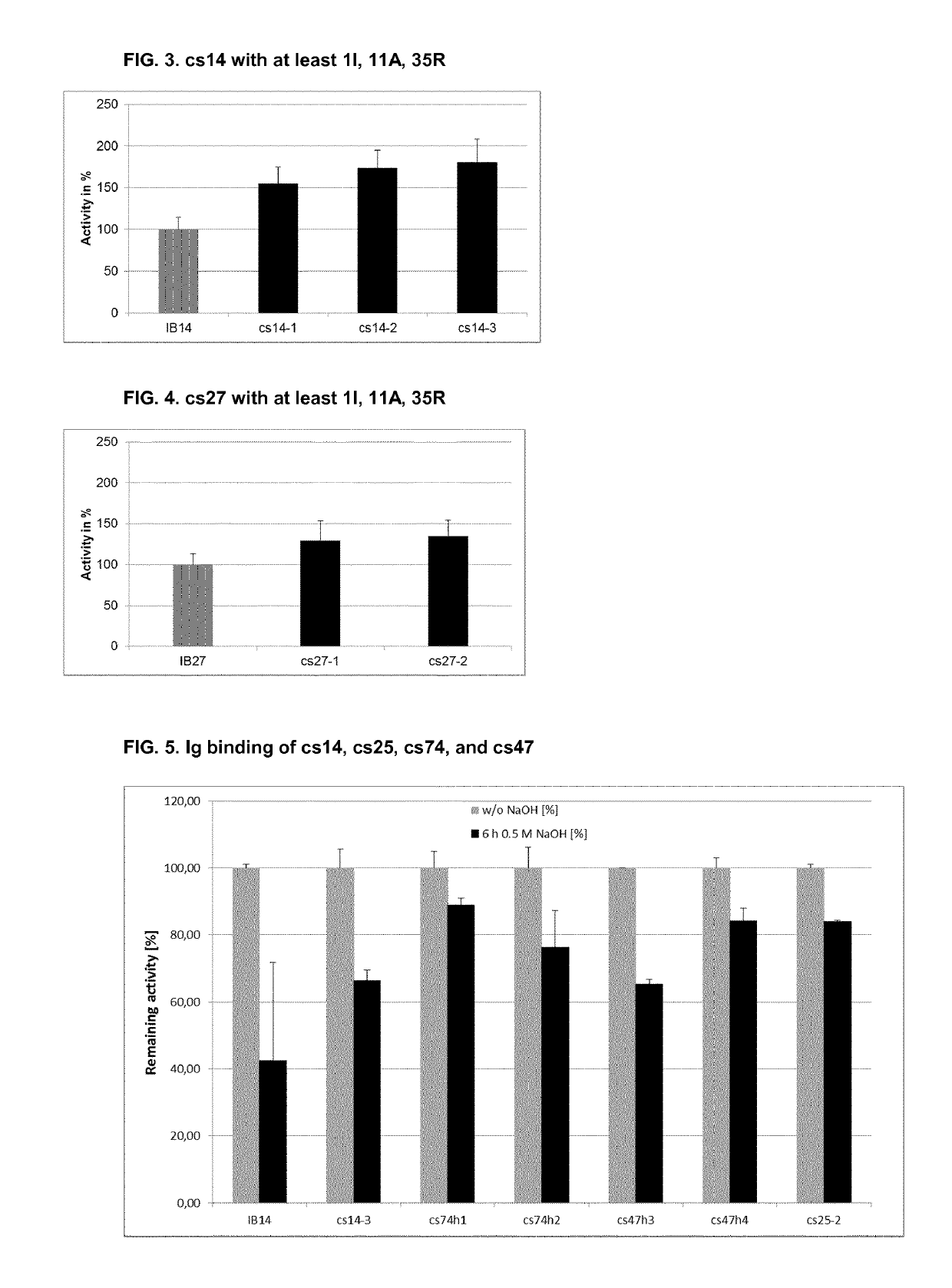Novel alkaline stable immunoglobulin-binding proteins
a technology binding proteins, which is applied in the field of alkaline stable immunoglobulin (ig) binding proteins, can solve the problems of immunoglobulin binding capacity loss in chromatography matrices, and achieve the effect of reducing the loss of immunoglobulin binding capacity
- Summary
- Abstract
- Description
- Claims
- Application Information
AI Technical Summary
Benefits of technology
Problems solved by technology
Method used
Image
Examples
example 1
n of Parental Proteins by Shuffling
[0143]Parental proteins (e.g. SEQ ID NOs: 3, 4, 10, 14, 21, 22, 25, 47-50) were initially generated by a shuffling process of naturally occurring Protein A domains and Protein A domain variants (e.g. Z domain or other domains with at least 89.5% identity to any naturally occurring domain, e.g. Z / 2 domain). In more detail, the shuffling process as understood herein is an assembly process resulting in artificial amino acid sequences starting from a set of non-identical known amino acid sequences. The shuffling process comprised the following steps: a) providing sequences of five naturally occurring Protein A domains E, B, D, A, and C, and Protein A variant domain Z or Z / 2; b) alignment of said sequences; c) statistical fragmentation in silico to identify subsequences that were recombined, and then d) assembly of new, artificial sequences of the various fragments to produce a mosaic product, i.e. a novel amino acid sequence. The fragments generated in...
example 2
is to Generate Variants
[0148]For site-directed mutagenesis, the Q5® site-directed Mutagenesis Kit (NEB; Cat. No. E0554S) was used according to the manufacturer's instructions. PCRs were carried out with oligonucleotides coding for each specific substitution respectively and a plasmid containing SEQ ID NO: 14 as template. Products were ligated and transformed into E. coli XL2-blue cells (Stratagene) via electroporation. Single colonies were isolated and DNA sequencing was used for insert containing clones to verify the correct sequences. Results are shown in FIG. 2. A combination of several point mutations was generated by GeneArt™ Strings™ synthesis (Thermo Fisher Scientific). The Strings DNA fragments corresponded to a purified PCR product and were cloned into a derivate of a pET28a vector. Ligation products were transformed into E. coli XL2-blue cells via electroporation. Single colonies were screened by PCR to identify constructs containing inserts of the right size. DNA sequenci...
example 3
n of Ig Binding Proteins
[0149]BL21 (DE3) competent cells were transformed with an expression plasmid encoding Ig binding proteins. Cells were spread onto selective agar plates (Kanamycin) and incubated overnight at 37° C. Precultures were inoculated from single colony in 100 ml 2xYT medium and cultured for 16 hours at 37° C. at 160 rpm in a conventional orbital shaker in baffled 1 L Erlenmeyer flasks supplemented with 150 μg / ml Kanamycin without lactose and antifoam. The OD600 readout should be in the range of 6-12. Main culture was inoculated from previous overnight culture with an adjusted start-OD600 of 0.5 in 400 ml superrich medium (modified H15 medium 2% Glucose, 5% Yeast extract, 0.89% Glycerol, 0.76% Lactose, 250 mM MOPS, 202 mM TRIS, pH 7.4, Antifoam SE15) in 1 L thick-walled Erlenmeyer flasks that was supplemented with 150 μg / ml Kanamycin. Cultures were transferred to a resonant acoustic mixer (RAMbio) and incubated at 37° C. with 20×g. Aeration was facilitated by Oxy-Pump...
PUM
| Property | Measurement | Unit |
|---|---|---|
| Fraction | aaaaa | aaaaa |
| Fraction | aaaaa | aaaaa |
| Fraction | aaaaa | aaaaa |
Abstract
Description
Claims
Application Information
 Login to View More
Login to View More - R&D
- Intellectual Property
- Life Sciences
- Materials
- Tech Scout
- Unparalleled Data Quality
- Higher Quality Content
- 60% Fewer Hallucinations
Browse by: Latest US Patents, China's latest patents, Technical Efficacy Thesaurus, Application Domain, Technology Topic, Popular Technical Reports.
© 2025 PatSnap. All rights reserved.Legal|Privacy policy|Modern Slavery Act Transparency Statement|Sitemap|About US| Contact US: help@patsnap.com


